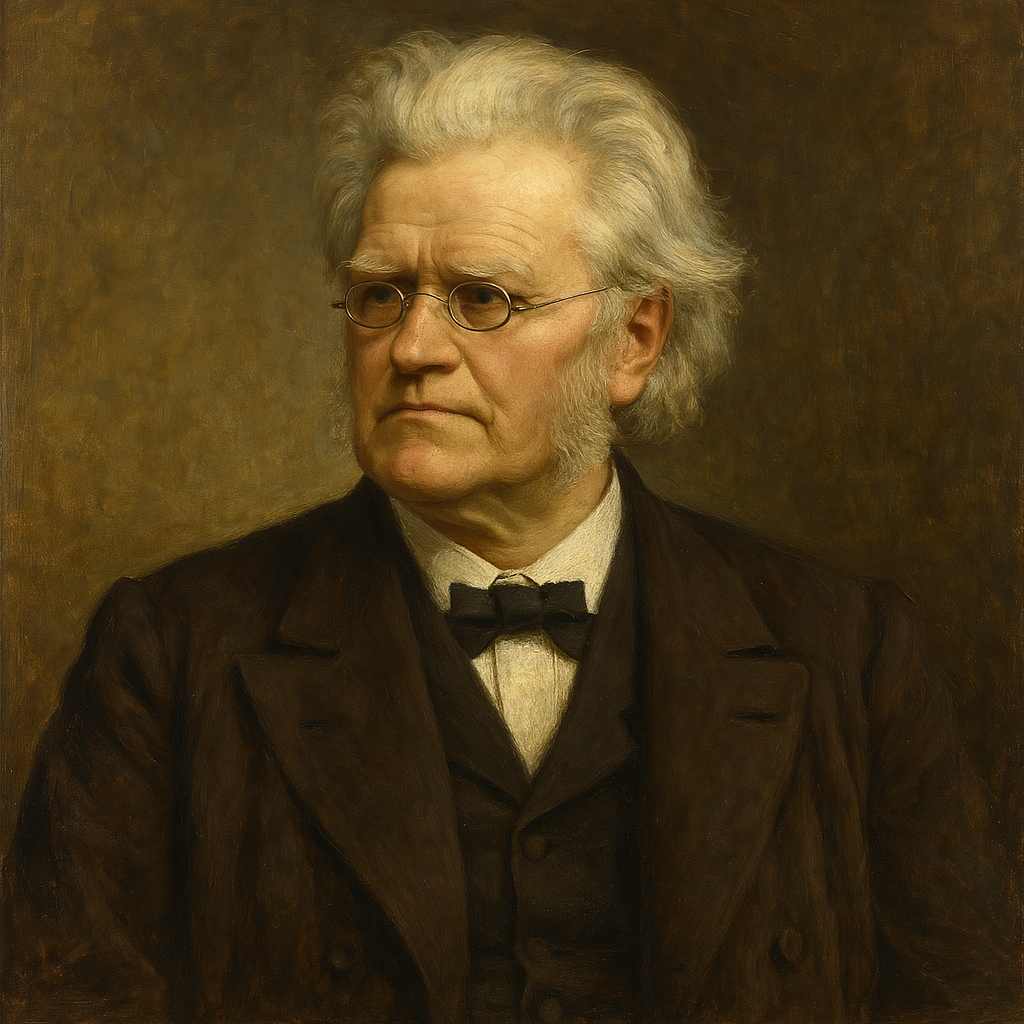The Princess (Norwegian)
Bjørnstjerne Bjørnson
1832 to 1910

Prinsessen
Prinsessen satt ene i jomfrubur,
gutten blåste i luren på fur.
"Hvorfor vil du alltid blåse, jeg ber?
Det binder de tanker som flakser her,
mens solen går ned."
Prinsessen satt ene i jomfrubur,
gutten var blitt taus med sin lur.
"Å, hvorfor er du stille, jeg ber?
Det gir vinger til tanker som flakser her,
mens solen går ned."
Prinsessen satt ene i jomfrubur,
gutten blåste igjen på sin lur.
Hun gråt, da skyggene vokste, og sa:
"Å, Gud, hva er det mitt hjerte vil ha,
nå solen er ned."
Bjørnstjerne Bjørnson's The Princess
Bjørnstjerne Bjørnson’s poem, The Princess, explores themes of longing, isolation, and the contrasting power of sound and silence. Through its repetitive structure and carefully modulated emotional shifts, the poem paints a picture of a princess confined in a “maiden bower,” grappling with her inner turmoil as she interacts with a young lad who plays a horn outside her tower. Each stanza follows a similar structure but shifts in tone, capturing the ebb and flow of the princess’s emotions as day fades into night.
Structure and Setting
The poem’s setting—a “maiden bower”—evokes a sense of medieval seclusion, a traditional motif that symbolizes virginity, purity, and emotional captivity. The princess is physically and emotionally isolated in this tower, cut off from the world, with her only connection to the outside being the sound of the lad’s horn. This spatial confinement enhances the poem's central theme of longing, as the princess's mind drifts beyond the boundaries of her confinement with the help or hindrance of the horn’s call.
The Dynamic of Sound and Silence
The poem is structured around an interplay between sound and silence, each affecting the princess in contrasting ways. In the first stanza, the lad’s horn-playing disturbs her thoughts:
"Why playest thou alway? Be silent, I pray,
It fetters my thoughts that would flee far away,
As the sun goes down."
The princess’s reaction to the horn’s sound as something that “fetters” her thoughts suggests that, at this moment, the music is a constraint, preventing her thoughts from reaching a more peaceful or distant place. The “sun goes down,” marking the approach of evening, often associated with introspection, loneliness, or melancholy. The lad’s playing disrupts her introspective state, binding her to her immediate surroundings.
In the second stanza, however, the absence of the horn has a reverse effect. Now, in the silence, the princess finds herself yearning for the lad’s music:
"Oh, why art thou silent? I beg thee to play!
It gives wings to my thought that would flee far away,
As the sun goes down."
The silence, once desired, now feels unbearable; it traps her within her own thoughts, which, without the horn, seem heavy and grounded. The phrase “It gives wings to my thought” is especially striking, suggesting that the horn’s music, while initially disruptive, ultimately liberates her mind, allowing her imagination or her longing to escape the confines of her tower.
Escalation of Emotion in the Final Stanza
The third stanza amplifies the emotional tension as nightfall deepens. The lad plays again, but this time, his music prompts a profound sorrow in the princess:
"She wept as the shadows grew long, and she sighed:
'Oh, tell me, my God, what my heart doth betide,
Now the sun has gone down.'"
The deepening shadows signify the transition from dusk to night, a time often associated with reflection, but also with loneliness and the unknown. Her tears indicate an overwhelming emotional release, suggesting that her longing is more than a simple wish for companionship or entertainment. The final line, a prayer to God, adds a layer of existential questioning. The princess, feeling an inner emptiness or a yearning she cannot fully understand, implores divine guidance: “what my heart doth betide,” or, in modern terms, “what is it that my heart truly seeks?”
Themes of Yearning and Unfulfilled Desire
Throughout the poem, the princess’s vacillating response to the lad’s horn symbolizes her internal conflict: a restless yearning for something beyond her present state, a need that neither sound nor silence alone can satisfy. This mirrors a broader theme in Romantic and post-Romantic poetry, where characters often seek a transcendent experience or meaning that remains perpetually elusive. The horn and its absence act as metaphors for the things we desire and the things we flee, yet ultimately need both to understand our deeper selves.
Conclusion
Bjørnstjerne Bjørnson’s The Princess is a poignant meditation on solitude, desire, and the complexities of longing. Through the simple yet profound interaction between the princess and the lad, Bjørnson delves into the tensions between confinement and freedom, sound and silence, and the conscious and unconscious yearnings of the human heart. The princess's final prayer underscores her search for something beyond herself, something she senses but cannot name. As the sun sets and night envelops her, the poem leaves us with an image of unresolved desire—a yearning for understanding that is as much about the self as it is about the world beyond the “maiden bower.”
This text was generated by AI and is for reference only. Learn more
Want to join the discussion? Reopen or create a unique username to comment. No personal details required!



Comments
No comments yet. Be the first to comment!